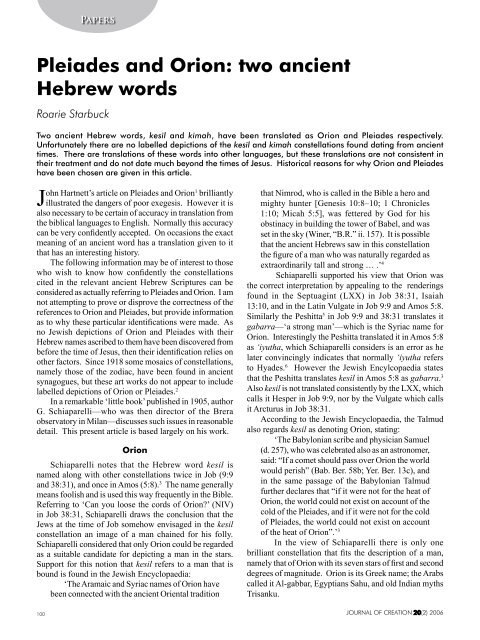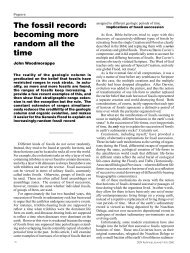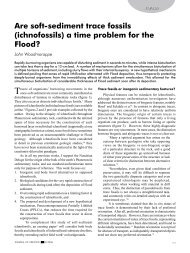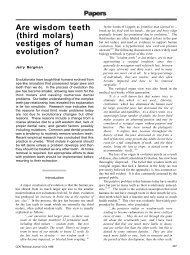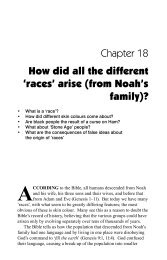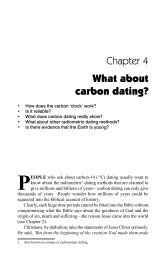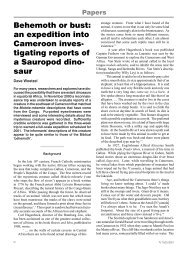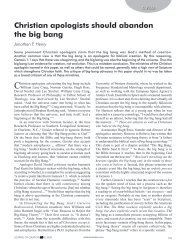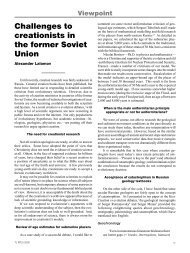Pleiades and Orion: two ancient Hebrew words - Creation
Pleiades and Orion: two ancient Hebrew words - Creation
Pleiades and Orion: two ancient Hebrew words - Creation
Create successful ePaper yourself
Turn your PDF publications into a flip-book with our unique Google optimized e-Paper software.
100<br />
Papers<br />
<strong>Pleiades</strong> <strong>and</strong> <strong>Orion</strong>: <strong>two</strong> <strong>ancient</strong><br />
<strong>Hebrew</strong> <strong>words</strong><br />
Roarie Starbuck<br />
Two <strong>ancient</strong> <strong>Hebrew</strong> <strong>words</strong>, kesil <strong>and</strong> kimah, have been translated as <strong>Orion</strong> <strong>and</strong> <strong>Pleiades</strong> respectively.<br />
Unfortunately there are no labelled depictions of the kesil <strong>and</strong> kimah constellations found dating from <strong>ancient</strong><br />
times. There are translations of these <strong>words</strong> into other languages, but these translations are not consistent in<br />
their treatment <strong>and</strong> do not date much beyond the times of Jesus. Historical reasons for why <strong>Orion</strong> <strong>and</strong> <strong>Pleiades</strong><br />
have been chosen are given in this article.<br />
John Hartnett’s article on <strong>Pleiades</strong> <strong>and</strong> <strong>Orion</strong>1 brilliantly<br />
illustrated the dangers of poor exegesis. However it is<br />
also necessary to be certain of accuracy in translation from<br />
the biblical languages to English. Normally this accuracy<br />
can be very confidently accepted. On occasions the exact<br />
meaning of an <strong>ancient</strong> word has a translation given to it<br />
that has an interesting history.<br />
The following information may be of interest to those<br />
who wish to know how confidently the constellations<br />
cited in the relevant <strong>ancient</strong> <strong>Hebrew</strong> Scriptures can be<br />
considered as actually referring to <strong>Pleiades</strong> <strong>and</strong> <strong>Orion</strong>. I am<br />
not attempting to prove or disprove the correctness of the<br />
references to <strong>Orion</strong> <strong>and</strong> <strong>Pleiades</strong>, but provide information<br />
as to why these particular identifications were made. As<br />
no Jewish depictions of <strong>Orion</strong> <strong>and</strong> <strong>Pleiades</strong> with their<br />
<strong>Hebrew</strong> names ascribed to them have been discovered from<br />
before the time of Jesus, then their identification relies on<br />
other factors. Since 1918 some mosaics of constellations,<br />
namely those of the zodiac, have been found in <strong>ancient</strong><br />
synagogues, but these art works do not appear to include<br />
labelled depictions of <strong>Orion</strong> or <strong>Pleiades</strong>. 2<br />
In a remarkable ‘little book’ published in 1905, author<br />
G. Schiaparelli—who was then director of the Brera<br />
observatory in Milan—discusses such issues in reasonable<br />
detail. This present article is based largely on his work.<br />
<strong>Orion</strong><br />
Schiaparelli notes that the <strong>Hebrew</strong> word kesil is<br />
named along with other constellations twice in Job (9:9<br />
<strong>and</strong> 38:31), <strong>and</strong> once in Amos (5:8). 3 The name generally<br />
means foolish <strong>and</strong> is used this way frequently in the Bible.<br />
Referring to ‘Can you loose the cords of <strong>Orion</strong>?’ (NIV)<br />
in Job 38:31, Schiaparelli draws the conclusion that the<br />
Jews at the time of Job somehow envisaged in the kesil<br />
constellation an image of a man chained for his folly.<br />
Schiaparelli considered that only <strong>Orion</strong> could be regarded<br />
as a suitable c<strong>and</strong>idate for depicting a man in the stars.<br />
Support for this notion that kesil refers to a man that is<br />
bound is found in the Jewish Encyclopaedia:<br />
‘The Aramaic <strong>and</strong> Syriac names of <strong>Orion</strong> have<br />
been connected with the <strong>ancient</strong> Oriental tradition<br />
that Nimrod, who is called in the Bible a hero <strong>and</strong><br />
mighty hunter [Genesis 10:8–10; 1 Chronicles<br />
1:10; Micah 5:5], was fettered by God for his<br />
obstinacy in building the tower of Babel, <strong>and</strong> was<br />
set in the sky (Winer, “B.R.” ii. 157). It is possible<br />
that the <strong>ancient</strong> <strong>Hebrew</strong>s saw in this constellation<br />
the figure of a man who was naturally regarded as<br />
extraordinarily tall <strong>and</strong> strong … .’ 4<br />
Schiaparelli supported his view that <strong>Orion</strong> was<br />
the correct interpretation by appealing to the renderings<br />
found in the Septuagint (LXX) in Job 38:31, Isaiah<br />
13:10, <strong>and</strong> in the Latin Vulgate in Job 9:9 <strong>and</strong> Amos 5:8.<br />
Similarly the Peshitta 5 in Job 9:9 <strong>and</strong> 38:31 translates it<br />
gabarra—‘a strong man’—which is the Syriac name for<br />
<strong>Orion</strong>. Interestingly the Peshitta translated it in Amos 5:8<br />
as ‘iyutha, which Schiaparelli considers is an error as he<br />
later convincingly indicates that normally ‘iyutha refers<br />
to Hyades. 6 However the Jewish Encylcopaedia states<br />
that the Peshitta translates kesil in Amos 5:8 as gabarra. 3<br />
Also kesil is not translated consistently by the LXX, which<br />
calls it Hesper in Job 9:9, nor by the Vulgate which calls<br />
it Arcturus in Job 38:31.<br />
According to the Jewish Encyclopaedia, the Talmud<br />
also regards kesil as denoting <strong>Orion</strong>, stating:<br />
‘The Babylonian scribe <strong>and</strong> physician Samuel<br />
(d. 257), who was celebrated also as an astronomer,<br />
said: “If a comet should pass over <strong>Orion</strong> the world<br />
would perish” (Bab. Ber. 58b; Yer. Ber. 13c), <strong>and</strong><br />
in the same passage of the Babylonian Talmud<br />
further declares that “if it were not for the heat of<br />
<strong>Orion</strong>, the world could not exist on account of the<br />
cold of the <strong>Pleiades</strong>, <strong>and</strong> if it were not for the cold<br />
of <strong>Pleiades</strong>, the world could not exist on account<br />
of the heat of <strong>Orion</strong>”.’ 3<br />
In the view of Schiaparelli there is only one<br />
brilliant constellation that fits the description of a man,<br />
namely that of <strong>Orion</strong> with its seven stars of first <strong>and</strong> second<br />
degrees of magnitude. <strong>Orion</strong> is its Greek name; the Arabs<br />
called it Al-gabbar, Egyptians Sahu, <strong>and</strong> old Indian myths<br />
Trisanku.<br />
JOURNAL OF CREATION 20(2) 2006
<strong>Pleiades</strong><br />
Next Schiaparelli discusses kimah, which also is named<br />
along with other constellations twice in Job (9:9 <strong>and</strong> 38:31),<br />
<strong>and</strong> once in Amos (5:8). 7 The LXX apparently consistently<br />
refers to the singular of this as Pleiad. Aquila in Job 38:31<br />
does likewise in his Greek version. The Peshitta in all three<br />
instances does not translate it, but merely has it in the form<br />
kima. However the Vulgate translates kimah differently in<br />
each of its three occurrences, rendering it Hyades, <strong>Pleiades</strong><br />
<strong>and</strong> Arcturus.<br />
The Peshitta is interesting in that all other <strong>Hebrew</strong><br />
constellations are translated into their Syriac equivalents.<br />
The only possible reasons for the Peshitta to make an<br />
exception with kimah by not translating it are:<br />
1) they did not know what constellation it referred to,<br />
or;<br />
2) kima in Syriac was the same name as kimah in<br />
<strong>Hebrew</strong>.<br />
The latter is more likely as numerous Syriac<br />
quotations referring to kima clearly do represent <strong>Pleiades</strong>,<br />
according to a list of such references made by Payne<br />
Smith. 8<br />
Professor Stern of Göttingen (1864–5) 9 wrote on<br />
the naming of the constellations in the book of Job.<br />
Schiaparelli refers to this in his Appendix II (pp. 163–175)<br />
<strong>and</strong> notes the following:<br />
‘Rabbi Joshua [in the Talmud, Rosh<br />
Hashshanah, p. 11], in speaking of the Flood,<br />
says that the rain began on the seventeenth day of<br />
the month Iyar, on which Kimar is accustomed to<br />
rise in the morning, <strong>and</strong> the springs begin to dry<br />
up. In consequence of the perverse behaviour of<br />
men, God also changed the order of the universe:<br />
in place of its morning rising, He caused Kimah<br />
to set in the morning, <strong>and</strong> removed <strong>two</strong> stars from<br />
it: the springs swelled <strong>and</strong> the Flood took place.<br />
According to Rabbi Eliezer, these changes took<br />
place on the seventeenth day of the month<br />
Marheshvan, when Kimah is accustomed to set<br />
in the morning, <strong>and</strong> the springs increase. God<br />
reversed the order of the universe: Kimah rose on<br />
the morning of that day, <strong>and</strong> lost <strong>two</strong> stars. The<br />
springs continued to increase <strong>and</strong> the Flood took<br />
place.’ 10<br />
Apparently Professor Stern then applied these<br />
Jewish calendar dates to the Julian calendar <strong>and</strong> showed<br />
that they correspond to the morning rising <strong>and</strong> setting of<br />
<strong>Pleiades</strong>. He thus concluded that at the time of these <strong>two</strong><br />
Rabbis, namely the beginning of the second century ad,<br />
kimah referred to <strong>Pleiades</strong>. The <strong>two</strong> stars taken from kimar<br />
were said by the Rabbis to have been given to ‘ayish, which<br />
then caused the rains to diminish. This is used to validate<br />
the interpretation of ‘ayish by these Rabbis as Hyades. It is<br />
important to note that the Talmudic account above is based<br />
on Stern’s interpretation after applying <strong>two</strong> corrections to<br />
Papers<br />
The <strong>Pleiades</strong> is a cluster of seven stars that the Greeks called the<br />
Seven Sisters. They are also part of Taurus the bull constellation,<br />
where they lie on the shoulder of the bull.<br />
the story to make it intelligible <strong>and</strong> coherent. The following<br />
is an English translation of this Talmudic account:<br />
‘R. Joshua <strong>and</strong> R Eliezer are herein consistent<br />
[with views expressed by them elsewhere],<br />
as it has been taught: “In the sixth hundredth<br />
year of Noah’s life, in the second month, on the<br />
seventeenth day of the month [Genesis 7:11]. R<br />
Joshua said: That day was the seventeenth day<br />
of Iyar, when the constellation of <strong>Pleiades</strong> sets at<br />
daybreak <strong>and</strong> the fountains begin to dry up, <strong>and</strong><br />
because they [mankind] perverted their ways, the<br />
Holy One, blessed be He, changed for them the<br />
work of creation <strong>and</strong> made the constellation of<br />
<strong>Pleiades</strong> rise at daybreak <strong>and</strong> took <strong>two</strong> stars from<br />
the <strong>Pleiades</strong> <strong>and</strong> brought a flood on the world.<br />
R. Eliezer said: That day was the seventeenth of<br />
Marheshvan, a day on which the constellation of<br />
<strong>Pleiades</strong> rises at daybreak, <strong>and</strong> [the season] when<br />
the fountains begin to fill [12a], <strong>and</strong> because they<br />
perverted their ways, the Holy One, blessed be<br />
He, changed for them the work of creation, <strong>and</strong><br />
caused the constellation of <strong>Pleiades</strong> to rise at<br />
daybreak <strong>and</strong> took away <strong>two</strong> stars [from it] <strong>and</strong><br />
brought a flood on the world” … on R. Joshua’s<br />
view we see what change there was in the work<br />
of creation; but on R. Elieaer’s view what change<br />
was there? [Emphasis <strong>and</strong> insertions are found in<br />
the English version].’ 11<br />
The English translators also add a footnote at<br />
the end of this quote, which states at the bottom of that<br />
page:<br />
‘There seems to be some confusion in the<br />
text here. To make it astronomically correct we<br />
should read (with the Seder Olam) in the dictum<br />
JOURNAL OF CREATION 20(2) 2006 101<br />
Image by Robert Gendler
Photo by NASA-GSFC<br />
102<br />
Papers<br />
[ie. statement] of R. Joshua, “When <strong>Pleiades</strong> rises<br />
at daybreak”, <strong>and</strong> in the dictum of R. Eliezer, “sets<br />
at daybreak” [emphasis is in the original].’<br />
Surprisingly, Professor Stern was led to believe<br />
from other considerations that these Rabbis were actually<br />
in error, <strong>and</strong> that originally kimah referred to Sirius (the<br />
dog), ‘ayish as <strong>Pleiades</strong>, mazzaroth as Hyades’, but<br />
maintained kesil was indeed <strong>Orion</strong>. Schiaparelli disputed<br />
the aberrant conclusions in a quite convincing manner.<br />
Referring to ‘Can you bind the beautiful/chains of<br />
<strong>Pleiades</strong>?’ (NIV) in Job 38:31, Schiaparelli notes that the<br />
LXX, Aquila <strong>and</strong> the Vulgate render it this way from the<br />
<strong>Hebrew</strong> ma’anaddoth for chains, though the Masoretic<br />
(<strong>Hebrew</strong>) text has ma’adannoth which means delicate/<br />
beautiful. Some more freely interpret this as ‘sweet<br />
influences’. The interpretation of ‘sweet influences’<br />
once led the famous oceanographer Maury 12 to make a<br />
connection between this biblical text <strong>and</strong> the hypothesis of<br />
Johann von Maedler. In 1846 Maedler, from the Estonian<br />
Dorpat Observatory, considered the <strong>Pleiades</strong> as the centre<br />
of the galaxy, <strong>and</strong> that one of its stars, Alcyone, was the<br />
centre of the universe. 13 The ‘sweet influences’ were thus<br />
considered as the force that bound the galaxy in orbit<br />
around it.<br />
<strong>Orion</strong> is often found by locating the three belt stars. Hanging from<br />
<strong>Orion</strong>’s belt is the sword consisting of the Trapezium (pictured here<br />
with it’s five massive stars) within the <strong>Orion</strong> Nebula (M42). <strong>Orion</strong>’s<br />
left knee is represented by one of the brightest stars in the night sky,<br />
Rigel. Left <strong>and</strong> right shoulders are made of the stars Bellatrix <strong>and</strong><br />
Betelgeuse, respectively.<br />
Translations<br />
To appreciate the importance of the various translations<br />
of the scriptures quoted above, the following brief details<br />
on their origins are given. The information is sourced from<br />
F. F. Bruce’s brilliant book The Books <strong>and</strong> the Parchments:<br />
Some chapters on the transmission of the Bible. 14<br />
• The Christians east of the Euphrates river, who were<br />
controlled largely by the Parthian empire at the time<br />
of Christ, needed translations of the Bible in their own<br />
language. This Syriac language is called Christian<br />
Aramaic, as it is written in a distinctive variation of<br />
the Aramaic alphabet. At first there were non-st<strong>and</strong>ard<br />
translations into Syriac, but later an official translation<br />
was instigated by Rabbulah, bishop of Edessa in ad<br />
411 to ad 435. He used the Byzantine Greek text.<br />
The Old Testament (OT) <strong>and</strong> New Testament (NT)<br />
parts combined are called the Peshitta. The Byzantine<br />
Greek text came from Constantinople (formerly called<br />
Byzantium) in the fourth century.<br />
• The Old Testament portion of the Latin Vulgate was<br />
translated by Jerome (his full name was Eusebius<br />
Sofronius Hieronymus) from about ad 386 to ad 405.<br />
Originally he used the LXX for his translation, but<br />
later regarded this as unsatisfactory. He then did the<br />
entire OT translation from the <strong>Hebrew</strong> Scriptures as<br />
apparently he regarded the LXX at that time as being<br />
too full of errors. 15<br />
• The Septuagint (LXX) was a translation of the <strong>Hebrew</strong><br />
OT for Greek speaking Jews, probably begun in the<br />
third century bc in Alex<strong>and</strong>ria. An official Jewish<br />
version of the first five books was probably written<br />
about a hundred years later, <strong>and</strong> quite possibly there<br />
were no official versions of the other books.<br />
• Aquila was a Jewish proselyte originally from the coast<br />
of the Black Sea, who lived in the first half of the first<br />
century ad. He translated the OT into Greek from a<br />
newly established <strong>Hebrew</strong> text.<br />
• The Masoretic (<strong>Hebrew</strong>) text referred to by Schiaparelli<br />
most likely referred to copies based on an<br />
edition printed in <strong>Hebrew</strong> by Jacob Ben Chayyim in<br />
1524–1525. This was based on <strong>Hebrew</strong> manuscripts<br />
not earlier than the 14th century. It was only from<br />
1937 that editions were printed based on more accurate<br />
manuscripts from the late tenth <strong>and</strong> early eleventh<br />
centuries.<br />
Conclusion<br />
Reasons for ascribing kesil <strong>and</strong> kimah to <strong>Orion</strong> <strong>and</strong><br />
<strong>Pleiades</strong> have been outlined above. Some will no doubt<br />
consider that these reasons are quite adequate. It is my<br />
opinion that it is not possible to be adamant about the<br />
identifications, given that the <strong>ancient</strong> translations were not<br />
consistent in their translations for kesil <strong>and</strong> kimah, <strong>and</strong> that<br />
the translations were made hundreds of years after Job,<br />
Isaiah, <strong>and</strong> Amos were first written.<br />
JOURNAL OF CREATION 20(2) 2006
References<br />
1. Hartnett, J., <strong>Pleiades</strong> <strong>and</strong> <strong>Orion</strong>: bound, unbound, or … ? Journal of<br />
<strong>Creation</strong> 18(2):44–48, 2004.<br />
2. Ness, L., Astrology <strong>and</strong> Judaism in Late Antiquity, Doctoral Thesis,<br />
Miami University, 1990, , 23 February<br />
2006.<br />
3. Schiaparelli, G., Astronomy in the Old Testament, Clarendon Press,<br />
Oxford, p. 60, 1905. This is an authorized English translation with many<br />
corrections <strong>and</strong> additions by the author. The original book was first<br />
published in Italian in 1903.<br />
4. <strong>Orion</strong>, Jewish Encyclopaedia, Blau L. (Ed.), Wynnewood, PA, 2002,<br />
, 11 February 2006. Winer, “B.R.” ii. 157<br />
refers to: Winer, G.B., Biblisches Realwörterbuch, 2 vols., Leipzig, 1820,<br />
1833, 1847.<br />
5. Refer to the section on translations in this article.<br />
6. Schiaparelli, ref. 3, pp. 161–163.<br />
7. Schiaparelli, ref. 3, p. 62.<br />
8. Smith, R.P., Thesaurus Syriacus, Oxonii: e typographeo Clarendoniano,<br />
Oxford Press, Clarendon, p. 1723, 1879–1901. It can only be presumed<br />
that Schiaparelli was citing from this particular edition.<br />
9. Stern, M.A., die Sternbilder in Hiob xxxviii. 31–32; in: Gieger’s Judische<br />
Zeitschrift iii, pp. 258–276, 1864–1865.<br />
10. Schiaparelli, ref. 3, p. 164.<br />
11. Simon, M., Rosh Hashanah; in: Epstein I. (Ed.), The Babylonian Talmud:<br />
Seder Mo‘ed, English translation, Soncino Press, London, vol. IV, p.<br />
42–43, 1961.<br />
12. Maury, M.F., Maury Sailing Directions, Washington, vol. i, p. 17,<br />
1858. This citation by Schiaparelli most likely refers to: Maury, M.F.,<br />
Explanations <strong>and</strong> Sailing Directions to Accompany the Wind <strong>and</strong> Current<br />
Charts, W.A. Harris, Washington, D.C., 1858–1859. First published<br />
in 1851, the updated <strong>two</strong>-volume edition of 1858–1859 provided a<br />
greatly enlarged text. Refer to: , September 2004. Lieutenant Matthew Fontaine<br />
Maury was an incredible oceanographer, born on 14 January 1806 near<br />
Fredericksburg, Virginia. In 1868 he moved to Lexington, Virginia, where<br />
he was appointed a professor of meteorology at the Virginia Military<br />
Institute. Refer to , September<br />
2004.<br />
13. , September 2004.<br />
14. Bruce, F.F., The Books <strong>and</strong> the Parchments: Some Chapters on the<br />
Transmission of the Bible, Pickering <strong>and</strong> Inglis, London, 1978.<br />
15. Bruce, ref. 14, p. 205.<br />
Roarie Starbuck has a B.Sc (Hons) in the biological sciences<br />
<strong>and</strong> a B.Phty (physiotherapy), both from the University<br />
of Queensl<strong>and</strong>, Australia. He <strong>and</strong> his wife operate a<br />
busy physiotherapy practice.<br />
Papers<br />
2 0 0 8 I N T E R N A T I O N A L C O N F E R E N C E<br />
on<br />
C R E A T I O N I S M<br />
Call for Papers<br />
High quality papers for the Sixth International<br />
Conference on <strong>Creation</strong>ism (ICC), 4–6 August 2008,<br />
San Diego, CA, are now invited for submission. In<br />
continuation of the Fifth ICC, the theme of the Sixth ICC<br />
is again Developing <strong>and</strong> Systematizing the <strong>Creation</strong><br />
Model of Origins, making the Sixth ICC also a ‘working’<br />
conference.<br />
The interested author should write a 500 word abstract<br />
of his/her paper as a Word document, categorize it<br />
according to the area classification listed at , <strong>and</strong> submit a copy no later than<br />
31 October 2006 as an attached file to an email to<br />
the Editorial Board Chairman at: . Early submission is highly recommended.<br />
Each submitted abstract will be evaluated by the Editorial<br />
Board Chairman in consultation with the Area-Editors<br />
responsible for the technical review process for possible<br />
inclusion into the review process. If accepted, the author<br />
will be sent an email from the Editorial Board Chairman<br />
no later than 31 December 2006 detailing acceptance<br />
of his/her paper <strong>and</strong> the Area-Editor to whom his/her<br />
paper has been assigned, along with the Technical<br />
Review Process Overview <strong>and</strong> Procedures <strong>and</strong> Instructions<br />
to Authors documents dealing with the review process<br />
<strong>and</strong> the format of ICC papers respectively as attached<br />
files. The author will then submit his/her paper to the<br />
designated Area-Editor no later than 30 June 2007.<br />
The Area-Editors will then send each paper to referees,<br />
work with the author to improve his/her paper, <strong>and</strong> have<br />
final jurisdiction over the acceptance or rejection of each<br />
such paper. Final drafts of all papers, including any<br />
revisions, are to be in the Area-Editor’s h<strong>and</strong>s no later<br />
than 31 January 2008. (These dates are firm!)<br />
Papers dealing with the age of the earth/universe must<br />
be from a young-earth perspective. Papers from an oldearth/old-universe<br />
perspective will not be considered.<br />
JOURNAL OF CREATION 20(2) 2006 103<br />
TM


